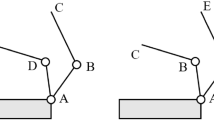Abstract
For a long time, it was believed that Alfred Kempe proved (1876) a theorem about the possibility of plotting an arbitrary planar algebraic curve by parts using hinge mechanisms (linkages). However, at the end of the 20th century, specialists in algebraic geometry, having rediscovered and developed this result in modern language, began to assert that Kempe’s reasoning contained significant gaps and errors. In the author’s opinion, these claims are unfounded. In this paper, by a detailed analysis of the notions of a linkage and its configuration space, the author tries to substantiate this point of view.
Similar content being viewed by others
References
T. Abbott, Generalizations of Kempe’s Universality Theorem, M.I.T., Cambridge, Massachusetts (2008).
I. I. Artobolevskii, Theory of Mechanisms [in Russian], Nauka, Moscow (1965).
L. Asimov and B. Roth, “The rigidity of graphs, II,” J. Math. Anal. Appl., 68, No. 1, 171–190 (1979).
O. Bottema and B. Roth, Theoretical Kinematics, North-Holland, Amsterdam (1979).
H. Crapo, “Structural rigidity,” Struct. Topol., No. 1, 26–45 (1979).
E. Demaine and J. O’Rourke, Geometric Folding Algorithms: Linkages, Origami, Polyhedra, Cambridge Univ. Press (2007).
E. A. Gorin, “On asymptotic properties of polynomials and algebraic functions of several variables,” Usp. Mat. Nauk, 16, No. 1 (97), 91–118 (1961).
J. Graver, B. Servatius, and H. Servatius, Combinatorial Rigidity, Am. Math. Soc., Providence, Rhode Island (1993).
D. Hilbert and S. Cohn-Vossen, Geometry and the Imagination, Chelsea, New York (1952).
K. H. Hunt, Kinematic Geometry of Mechanisms, Clarendon Press, New York (1978).
D. Jordan and M. Steiner, “Configuration spaces of mechanical linkages,” Discr. Comput. Geom., 22, 297-315 (1999).
M. Kapovich and J. J. Millson, “Universality theorems for configurations of planar linkages,” Topology, 41, No. 6, 1051–1107 (2002).
A. B. Kempe, “On a general method of describing plane curves of the nth degree by Linkwork,” Proc. London Math. Soc., 7, No. 102, 213–216 (1876).
H. C. King, Planar linkages and algebraic sets .
H. C. King, Semiconfiguration spaces of planar linkages .
H. C. King, Configuration spaces of linkages in .
M. D. Kovalev, “Geometric Theory of Hinge Devices,” Izv. Ross. Akad. Nauk. Ser. Mat., 58, No. 1, 45–70 (1994).
M. D. Kovalev, “On the reconstructibility of frameworks from self-stresses,” Izv. Ross. Akad. Nauk. Ser. Mat., 61, No. 4, 37–66 (1997).
M. D. Kovalev, “Stability of hingers, hinged devices and schemes,” J. Math. Sci., 105, No. 2, 1848–1860 (2001).
M. D. Kovalev, “Questions of the geometry of hinged devices and schemes,” Vestn. Bauman Tekhn. Univ. Ser. Mashinostroenie., No. 4, 33–51 (2001).
M. Kovalev, “Results and problems of the geometry of hinged devices,” in: Proc. 12th World Congr. in Mechanism and Machine Science, Besan¸con, France (2007), pp. 18–21.
N. I. Levitskii, Theory of Mechanisms and Machines. Terminology [in Russian], Nauka, Moscow (1984).
A. A. Oshemkov, F. Yu. Popelenskii, A. A. Tuzhilin, A. T. Fomenko, and A. I. Shafarevich, A Course of Geometry and Topology [in Russian], LENAND, Moscow (2015).
S. Power, Elementary proofs of Kempe universality .
Author information
Authors and Affiliations
Corresponding author
Additional information
Translated from Itogi Nauki i Tekhniki, Seriya Sovremennaya Matematika i Ee Prilozheniya. Tematicheskie Obzory, Vol. 179, Proceedings of the International Conference “Classical and Modern Geometry” Dedicated to the 100th Anniversary of Professor Vyacheslav Timofeevich Bazylev. Moscow, April 22-25, 2019. Part 1, 2020.
Rights and permissions
Springer Nature or its licensor (e.g. a society or other partner) holds exclusive rights to this article under a publishing agreement with the author(s) or other rightsholder(s); author self-archiving of the accepted manuscript version of this article is solely governed by the terms of such publishing agreement and applicable law.
About this article
Cite this article
Kovalev, M.D. What is a Hinge Mechanism? What did Kempe Prove?. J Math Sci 276, 366–378 (2023). https://doi.org/10.1007/s10958-023-06751-0
Published:
Issue Date:
DOI: https://doi.org/10.1007/s10958-023-06751-0




